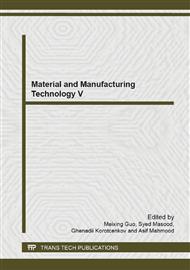p.126
p.132
p.136
p.141
p.147
p.152
p.157
p.162
p.169
Computational Analysis of Single and Multiple Impacts of Low Pressure and High Pressure Cold Sprayed Aluminum Particles Using SPH
Abstract:
Cold spray (CS) is a unique spraying process where the spray materials are not melted in a spray gun. Instead, the particles are kinetically deposited on the substrate at low temperature using compressed gas. This study investigates the bonding mechanism of low pressure CS (LPCS) and high pressure CS (HPCS) techniques through smoothed particle hydrodynamics (SPH) simulations, which are achieved by modeling the single and multiple particle impacts of aluminum (Al) particles on Al substrate. The impact of Al particles on the Al substrate is analyzed by evaluating the velocity, shape, temperature of the powder particles and substrate, porosity between particles, and effect of stress on the substrate. In the case of single particle impact, HPCS results in increased particle deformation. In multiple particle impact, LPCS results in low porosity. The shape of deformation, formation of pores, and residual stress of Al can be affected by the deposition process. Results indicate that LPCS is suitable for the deposition of light materials such as Al.
Info:
Periodical:
Pages:
147-151
Citation:
Online since:
June 2014
Price:
Сopyright:
© 2014 Trans Tech Publications Ltd. All Rights Reserved
Share:
Citation:


